
Exhibitions: Current | Upcoming | Past
Exhibitions: Past
9th Annual Azorean Traditional Nativity Exhibit
Exploring a Tradition in Azorean Art
With a Presentation by Mr. Roberto Medeiros and Demonstration by Figurine Artisan Mr. Antonio
December 7 – 31 2008
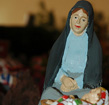
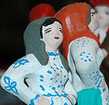
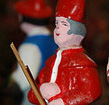
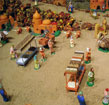
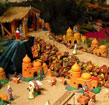
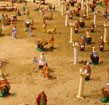
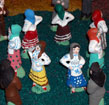
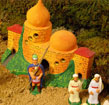
A Tradition to keep alive!
The production of nativity figurines is a tradition of the Town of Lagoa. The production of nativity figurines in Lagoa started in the second half of the 19th century, when two ceramics factories started their activity in the village. Many of the figurines were produced in improvised work areas at home, after work, as most of these artists worked in the ceramics factories during the day. As a matter of fact, this was a way of increasing the family income and it also helped to occupy free time. In the Azorean Nativity Scene Museum – the only Nativity Scene Museum in the Azores- one can find a vast collection of figurines that represent scenes of the daily life of the island of Sao Miguel.
The technical process of producing a figurine obeys to some rules and techniques and as it is an artisanal process, all the pieces are unique.
The Pottery industry is one of the oldest of Sao Miguel, in the end of the 15th century the Azoreans already used pottery produced in the islands, with Moorish and Spanish influences, as the methods and forms used in the production of these pieces were very similar to the ones used in the Potteries of Valencia, Paderna and Menisses.
One can also find Greek and Roman influences in the Pottery of Sao Miguel, as there was a mixture of civilizations in the Iberian Peninsula that one can see in the traces and colour of the Pottery of Santa Maria, Vila Franca do Campo and later in the white glazed Lagoa Pottery. The oldest Pottery Factories of the Azores are known in Santa Maria and Vila Franca do Campo, where the increasing number of the population and the requirements of the social and domestic life where responsible for the appearance of 27 pottery artisans in Ponta Delgada in the 17th Century.
In 1862 Ceramica Vieira is founded, later in 1872 Ceramica Leite also is founded in Lagoa, these were determinant facts that contibuted for the appearance of the Nativity Scene figurines in Lagoa.
When starting a visit to the AZOREAN NATIVITY SCENE MUSEUM, situated in the City Hall Building of Lagoa, one can examine a map of Lagoa showing the geographic distribution of most of the figurine makers, as well as their connections to the two Ceramic factories based in the municipality: Ceramica Vieira, founded in 1862 and still in activity today, leading many to consider it the most famous symbol of Lagoa, and Ceramica Leite, founded in 1872 and deactivated in 1984.
Visitors may also observe a series of photographs of artists of Nativity Scene Figurines, showing one photo of each of these artists in relation to a figurine creation for each, in an attempt to alert the public to the issue of individual production in relation to the style developed by each artisan.
One of the displays shows the Technical Process for Producing a Nativity Scene Figurine, systematically and sequentially presenting the various phases of production -molding, trimming and painting. In this manner, the clay is worked with the aid of plaster molds, small knives, varied paints, fine paintbrushes and much manual creativity, becoming a nativity scene figurine in the end.
Next, we find the Nativity representations – The Holy Family, the representation of the Grotto and Stable, The Cow and Donkey, the Shepherds, the Wise Men, the Angels, the representation of the "Flight to Egypt", as well as some Biblical figures: Arabs, Roman soldiers, etc., all indicative of the very religious tradition of the Azores.
The representation of Biblical Scenes leads Lagoa artisans to recreate architectural elements: castles, towers, houses, etc. – grouped in this exhibit under the title: Constructions of Jerusalem.
The visitor may also appreciate images evoking Daily Azorean Island Reality: a Procession of Senhor Santo Cristo dos Milagres, comprising two hundred and twenty eight figures, as well as other scenes of daily life: the farmer tiling the land, the raising and killing of the pigs; the bullfights; the utilization of water for hygiene and laundering; the grinding of cereals for bread making; wine making; the cleaning of public streets, garbage collecting; business in a cafe-bar: ice-cream vending; figurines of social satire and criticism and a scene from modern life– two men in front of the hearth.
The analysis of nativity scene figurines, allied with ethnological knowledge, helps us understand how their creation reveals the knowledge that these artisans, and those around them, have of the Holy Scriptures, as well as the capacity they demonstrate for capturing the daily scenes they witness with great astuteness and sagacity. As a result, we can affirm that, along with the religious theme in question – The Birth of Christ – the depiction of society is the inspiration leading to the production of nativity Scene figurines.
Within the scenes, therefore, and beyond the treatment of the central theme of the nativity, moments and situations from daily life and society are represented. In this manner, we can say that the figurines produced in Lagoa for the Nativity Scene Space, reveal aspects of the society, as well as popular interpretation of Biblical Texts. Consequently, through the study of the representations depicted in nativity scenes, we can become better acquainted with habits, rituals and customs from the present and the past, since these creations mirror everyday life.
The main objectives of the AZOREAN NATIVITY SCENE MUSEUM are to be a space of ethnological research, to conserve and to promote the creative activity of Lagoa's craftsmen, to be an informative centre about Azorean nativity scenes, to be a teaching laboratory specialized in visual expression and communication and to be a space of discovery and meeting of persons and cultures.
The Azorean Nativity Scene Museum was inaugurated on March 21, 1996. In September of the same year a smaller replica was on display in Toronto, Canada during the 10th Azorean Culture Week. Later the traditional Nativity Scene of Lagoa was in exhibition in the United States, at the "Old Colony Historical Society Museum of Taunton" in 2000; in New Bedford at the "Whaling Museum", at the "Artworks Galleries" and "Rotch-Jones Duff House" in 2001; in East Providence at the "Library of St. Francis Xavier Church" in 2002. In November 2003 the Nativity Scenes of Lagoa where represented in the "Cape Code Creche Convention" that took place in Hyannis, Mass.; in December 2003 in the "Centro Comunitario dos Amigos da Terceira" in Pawtucket- Rhode Island the Nativity Scene of Lagoa was on display along with a Agua de Pau basket maker, finally, it was on display at the "Taunton Lights Festival" with a basket maker from Agua de Pau, Azores and the guitars group from Friends of Terceira of Pawtucket.
In the year of 2004 the Lagoa Nativity Scene was exhibited in many cities of the USA and Canada. In November it was in the "Sanctuary of La Salette Shrine" in Attleboro MA. , next it went to New Bedford where it was on display at the "Casa da Saudade" Library. In December the Lagoa Nativity Scene went to the Lusitania Cultural Association in Fall River, USA and to the library of the Sainte-Therese Town Hall in Quebec-Canada. Finally in Dartmouth, USA there was an exhibition that displayed nativity scene figurines handmade by the figurine makers of Lagoa from figurine molds from Dartmouth.
In the 2005 Christmas the Lagoa Nativity Scene was exhibit in the Fairhaven's Millicent Library in Massachusetts, in the Dartmouth Library and in the New Bedford Whaling Museum.
In 2006 it was exhibited in the Bristol Statehouse / County Courthouse in Bristol, in the Roger Williams University, Dartmouth Library, Fairhaven's Millicent Library, Library of "Casa da Saudade" and in the La Salette Shrine in Attleboro, MA. It was also in Obidos, Portugal mainland.
In 2007 the Lagoa Nativity Scene was exhibited in Newport, USA, in the Belcourt Castle, one of the most famous mansions of that area.
During the month of December of 2008 the Lagoa Nativity Scene will be exhibited in the Bristol Community College (BCC) in Fall River, MA and the nativity scene figurine maker, Antonio Morais, from Lagoa will be working live during the exhibit.
The Cultural Department of Lagoa Town Hall promotes Nativity Scene contests during Christmas time since 1990. Many families, schools and cultural associations participate in these contests by making the most original and imaginative nativity scenes and then showing them in their houses to the judges of the competition. Even the figurines artisans do their own displays at the City Hall Building during Christmas time. In December 2002, Lagoa City Hall sponsored displays in private homes in New Bedford, Fall River, Dartmouth and Taunton as well as in Bristol, East Providence, California, Canada and in the "Graciosa Museum" in the Azorean island of Graciosa.
All these initiatives have the purpose of defending and preserve the clay figurine art of Lagoa and to keep holiday tradition alive; making sure the old custom does not die altogether.

